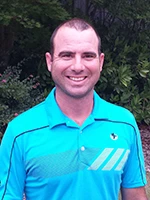
With 45 acres of Zorro Zoysia to care for at The Creek Club at Reynolds Plantation in Greensboro, Ga., superintendent Hoyt Ellspermann planned to keep large patch (Rhizoctonia solani) at bay, and the course looking great to meet expectations. Part of that plan is keeping the greens committee and members informed.
“Large patch is one disease that you really have to stay ahead of,” says Ellspermann. “I have developed a multi-faceted program combining cultural practices and control products to accomplish that.”
From a cultural standpoint he has cut back on fertilization, especially in the fall. “I use a UF slow release nitrogen in the spring and no quick release fertilizer,” he says, “In August/September I just spray some iron for color.”
On watering, he tries not to water the turf any more than it needs. He likes to keep it on the drier side. “Zoysia doesn’t need a lot of water, but does need some at times. I just try to keep a close eye on potential hot spots,” he says. Proper drainage is important. “If you have a wet season you don’t want the excess moisture to stay on the surface. Improving drainage is always a good way to decrease the amount of disease.
“I keep mowing heights low during most of the growing season except for a slight increase in height toward the end of the summer and I don’t mow when it is wet if at all possible.”
Ellspermann feels the most important tool in his toolbox is the preventive fall fungicide applications. Like most superintendents, he likes to do some rotation of products to avoid any possibility of resistance development. He makes his first application in the first part of September. He tries to time it when the temperatures start dropping and follows that with a second application 28 to 30 days later. His budget allows him to treat all 45 acres. He also budgets another application for spring cleanup, making those when the turf is about 30 percent coming out of dormancy. He doesn’t budget extra for labor as the applicators are there anyway and he makes his fall applications in conjunction with his iron applications.
No matter how well he plans, he knows there is going to be some breakthrough. “The breakthroughs are weather-related,” says Ellspermann. “Sometimes I can get by with spot treatment in the spring, especially in areas that aren’t as critical cosmetically. The grass will grow out of it, but there are areas that need special treatment for cosmetics.”
The other tool that is a big part of Ellspermann’s plan is communication. He says, “I have a blog. I include information about diseases, what they are, what they might cause and what I will be doing about them.” He started his blog in 2011. He says, “It is not the easiest thing to update and I don’t update it every single week. I do make sure that when I start getting any questions, I start addressing them on my blog. It’s an added tool, just another way to communicate.”
Latest from Golf Course Industry
- From the publisher’s pen: Conscientious of a bigger role
- Bernhard and Company partners with Laguna Golf Phuket
- Terre Blanche showcases environmental stewardship
- VIDEO: Introducing our December issue
- Bernhard and Company introduces Soil Scout
- Nu-Pipe donates to GCSAA Foundation’s Centennial Campaign
- GCSAA enhances golf course BMP tool
- Melrose leadership programs sending 18 to 2026 GCSAA Conference and Trade Show





